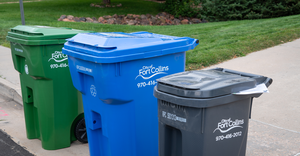Evaluating Opportunities for Resource Recovery in Waste Management
October 21, 2021

Brooke Marten
Recent organic waste diversion regulations aim to reduce the environmental burden associated with landfilling this waste stream. Pyrolysis is a promising waste management strategy for the organic fraction of municipal solid waste (OFMSW) that recognizes the value of this waste stream. Traditionally, organic waste is landfilled where it anaerobically degrades. To reduce the release of fugitive emissions, most modern landfills capture generated gas and combust it for energy generation. Unfortunately, this process of energy generation is rife with inefficiencies; nonetheless, emissions can still be generated due to inefficiencies, particularly when methane is generated prior to gas wells being installed or when the quantity or quality of gas is low.
On the other hand, organic waste pyrolysis offers an opportunity to improve energy production from waste. Pyrolysis involves heating a shredded and dried waste to high temperatures in the absence of oxygen, generating two useful products in the process: syngas and biochar. The highly engineered pyrolysis environment allows for greater control over gaseous and liquid emissions, which not only improves energy yield from waste, but it also reduces the environmental impacts associated with organic waste management. This novel waste management approach could revolutionize how discarded organics are managed and enhance its value as a resource. Because syngas and biochar have value and could be sold, OFMSW pyrolysis also presents a potential opportunity to reduce the cost of municipal solid waste management in a sustainable way.
The first useful by-product of pyrolysis, syngas, is comprised primarily of hydrogen, carbon monoxide, carbon dioxide, and hydrocarbons (e.g. CH4, C2H4). After being cleaned to remove impurities, syngas can be combusted to 1) generate heat, which can be readily used internally to dry the incoming feedstock; and 2) generate electricity. The amount of electrical energy generated via pyrolysis is competitive with other waste to energy operations including anaerobic digestion, incineration, and landfilling with landfill gas capture and combustion. Further, syngas combustion is a consistent and controllable energy source, a desirable feature not all renewable energy operations exhibit.
The second useful by-product of pyrolysis, biochar, is being considered for a variety of applications including use as a soil amendment, adsorbent, and landfill cover material. Land applying biochar has been shown to improve soil fertility, specifically soil nutrient retention and availability, so it could offset fertilizer use in agricultural settings. Alternatively, biochar has desirable sorption properties, and has often been compared to activated carbon, which is commonly created from non-renewable resources. Using OFMSW-derived biochar instead of activated carbon to treat landfill leachate is a circular economy opportunity. Another circular economy opportunity involves applying biochar as a daily landfill cover material, where it not only may promote oxidation of methane to carbon dioxide, but it could also offset the use of conventional daily landfill cover materials like soil.
While the pyrolysis of organic waste sounds promising, the true environmental implications, costs, and practicality of this novel waste management strategy need to be evaluated relative to more common management approaches. An EREF scholar at the University of Colorado Boulder is using life cycle assessment (LCA) methodology to obtain a holistic understanding of the true environmental impacts of OFMSW pyrolysis. Preliminary data suggests that OFMSW pyrolysis could lead to net global warming offsets, meaning that the benefits obtained from energy production and biochar use outweigh any greenhouse gas emissions involved in the system’s life cycle.
Organic waste diversion regulations are already being adopted across the country, leaving the solid waste industry responsible for developing and implementing alternative methods of managing the organic waste stream. OFMSW pyrolysis 1) offers an alternative strategy for managing the organic fraction of municipal solid waste 2) creates valuable by-products and 3) reduces environmental impacts, such as global warming impacts, as proven quantitatively using LCA. By creating products of value, the economic viability of this waste management strategy is improved. The production of syngas and biochar, along with an overall reduction in fugitive landfill emissions, bolster the environmental sustainability of pyrolysis. Overall, pyrolysis has the potential to serve as a viable waste management strategy for the OFMSW.
Brooke Marten began pursuing her PhD in Environmental Engineering at the University of Colorado at Boulder in Fall 2019 and plans on graduating in the Spring of 2024. She was awarded the Tom J. Fatjo Scholarship from the Environmental Research & Education Foundation (EREF) in 2020. Her research efforts at UC-Boulder focus on evaluating waste-derived biochar as an adsorbent and energy source using life cycle assessment methodology. Learn more about Brooke and her work on EREF’s website.
You May Also Like


